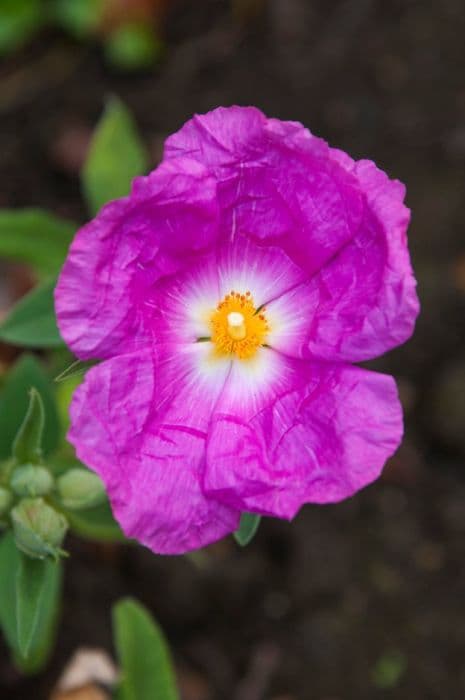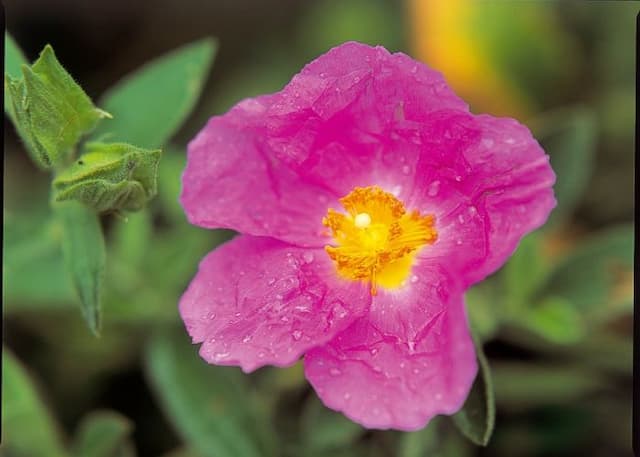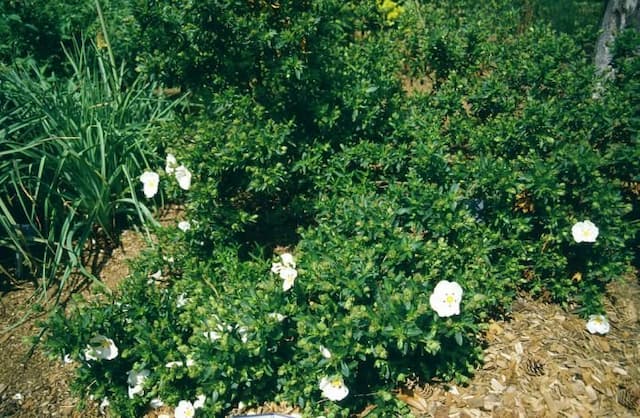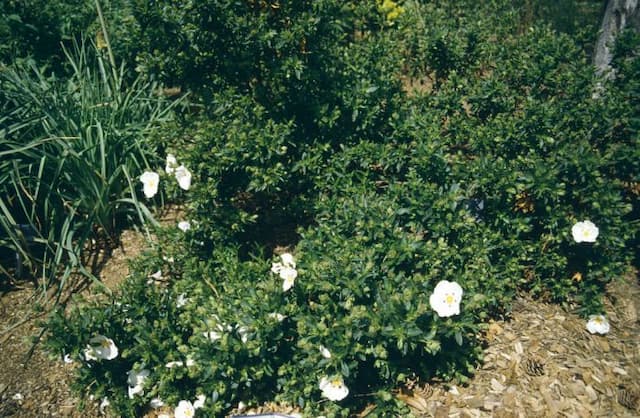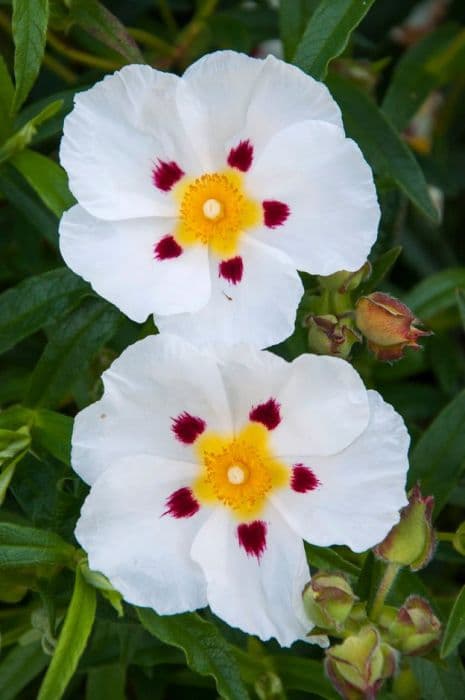Rock Rose × Halimiocistus wintonensis 'Merrist Wood Cream'

ABOUT
The × Halimiocistus wintonensis 'Merrist Wood Cream', commonly referred to as the rock rose or sun rose, is a captivatingly attractive ornamental shrub. Renowned for its beauty, this plant showcases an array of exquisite cream-colored flowers detailed with a prominent maroon-stained blotch at the base of each petal. These vibrant blooms, reminiscent of satin, emerge in the late spring to early summer, presenting a striking contrast against the evergreen backdrop of the foliage. The leaves are small, grayish-green, and narrow, with a slightly hairy texture that lends a silvery hue and a soft look and feel to the overall plant. The stems are woody, giving this shrub a robust and resilient structure that supports the flowers as they sway gracefully in the breeze. The rock rose is appreciated for its showy appearances and is commonly utilized in garden landscapes to invite an eye-catching splash of color. This plant's aesthetics are defined not only by its alluring flowers but also by its tidy, mounded form, which offers a neat and concise shape that smoothens into the garden's design. The overall appearance is characterized by the harmonious blend of its delicate, creamy blossoms with the subtle, refined foliage, creating an array of textures and hues. It encapsulates a sense of elegance and rustic charm, making it a popular choice for gardeners seeking to add a touch of sophistication to their outdoor spaces. The vibrant and enduring rock rose envelops the garden in a warm, inviting atmosphere and demands very little to remain a stunning feature in a diverse array of landscaping styles.
About this plant
 Names
NamesFamily
Cistaceae
Synonyms
Rock Rose, Cistus Halimium Hybrid
Common names
× Halimiocistus wintonensis 'Merrist Wood Cream'.
 Toxicity
ToxicityTo humans
The Rock Rose is not widely known for its toxicity to humans. There is limited information regarding severe adverse effects from ingesting this plant. However, as with many plants, it may cause mild discomfort if ingested, like stomach upset or an allergic reaction. Always exercise caution and keep plants away from children who might ingest them out of curiosity.
To pets
The Rock Rose is not widely known for its toxicity to pets. Like with humans, there is limited information on severe toxicity in common domestic animals such as cats and dogs. However, as a general precaution, it is advisable to prevent pets from ingesting plants, as they could potentially cause gastrointestinal upset or an allergic reaction in sensitive animals. If you suspect your pet has ingested this plant and is showing symptoms of distress, consult a veterinarian.
 Characteristics
CharacteristicsLife cycle
Perennials
Foliage type
Evergreen
Color of leaves
Green
Flower color
Cream
Height
2 feet (0.61 meters)
Spread
3 feet (0.91 meters)
Plant type
Shrub
Hardiness zones
8
Native area
Mediterranean
Benefits
 General Benefits
General Benefits- Ornamental Appeal: Adds aesthetic value to gardens with its creamy white flowers and attractive evergreen foliage.
- Drought Tolerance: Once established, it can withstand dry conditions, requiring less watering.
- Low Maintenance: Requires minimal care once established, making it suitable for low-maintenance landscapes.
- Hardiness: Tolerates a range of temperatures, making it suitable for various climates.
- Pollinator Attraction: Flowers attract bees and other pollinators, supporting biodiversity.
- Compact Growth: Its small size makes it ideal for smaller gardens or spaces.
- Deer Resistance: Generally resistant to browsing by deer, protecting it from wildlife damage.
 Medical Properties
Medical PropertiesThis plant is not used for medical purposes.
 Air-purifying Qualities
Air-purifying QualitiesThis plant is not specifically known for air purifying qualities.
 Other Uses
Other Uses- Halimiocistus wintonensis 'Merrist Wood Cream' can serve as an inspiration for artists and designers with its intricate flower pattern and subtle color palette.
- The plant can be used in educational settings as an example of plant hybridization, illustrating the concept of interspecific breeding for gardening enthusiasts and biology students.
- Dried petals of the Shrubby Rockrose can be incorporated into homemade potpourri for a natural and delicate fragrance.
- The dense foliage offers a good nesting ground for insects, providing a habitat and helping to sustain local biodiversity.
- Used as a living mulch, the plant can help suppress weeds due to its spreading growth habit, conserving garden maintenance efforts.
- Photographic subjects for macro photography, showcasing the natural beauty and intricate details of 'Merrist Wood Cream' flowers.
- Serves as a low-maintenance option for setting up a garden backdrop for outdoor social events or ceremonies with its aesthetic presence.
- Can be planted in memory gardens as a perennial tribute, symbolizing remembrance with its persistent blooms.
- Using the branches for crafting, such as making small wreaths or adding a natural touch to handcrafted decorations.
- Adding to ecological green roofs, where it can thrive with minimal care and contribute to urban biodiversity.
Interesting Facts
 Feng Shui
Feng ShuiThe Halimium is not used in Feng Shui practice.
 Zodiac Sign Compitability
Zodiac Sign CompitabilityThe Halimium is not used in astrology practice.
 Plant Symbolism
Plant Symbolism- Resilience: The × Halimiocistus wintonensis 'Merrist Wood Cream', commonly known as Rock Rose, is a symbol of resilience as it can thrive in poor soil and resist drought, reflecting an ability to persevere through challenging conditions.
- Beauty and Simplicity: Because of its simple yet attractive flowers, the Rock Rose embodies beauty that does not require lavish care, teaching the value of natural, understated elegance.
- Protection: In some traditions, the Rock Rose is considered a plant that offers protection due to its toughness and ability to create natural barriers with its dense growth.
- Renewal: This plant often blooms repeatedly throughout the growing season, making it a symbol of renewal and the ongoing cycle of life.
- Healing: The Rock Rose has been used in herbal remedies and Bach flower remedies, standing as a symbol of healing and the restorative power of nature.
 Water
WaterFor 'Merrist Wood Cream', or Rock Rose, water when the top couple of inches of soil feel dry to the touch, approximately once every week during its active growing season in spring and summer, but reduce to once every two to three weeks during dormancy in fall and winter. The method should be deep and thorough watering, allowing water to reach the root zone. Apply about 1 gallon of water for small to medium-sized plants, ensuring it is distributed evenly around the base of the plant. Avoid overhead watering to prevent diseases and do not let the plant sit in waterlogged soil as this could lead to root rot.
 Light
Light'Merrist Wood Cream' Rock Rose thrives best in full sun to partial shade. Ideally, it should receive at least 6 hours of direct sunlight each day. An east or west-facing garden spot where it can soak up morning or late afternoon sun while being shielded from the intense midday heat is perfect for this plant.
 Temperature
Temperature'Merrist Wood Cream' Rock Rose enjoys a temperate climate and can withstand a temperature range roughly from 20°F in winter to temperatures well above 80°F in the summer, making it quite resilient. The ideal growing temperature for this plant is between 60°F and 75°F. These temperature ranges typically ensure good growth and flowering.
 Pruning
PruningPrune 'Merrist Wood Cream' Rock Rose to maintain shape and encourage bushier growth. The best time for pruning is after the plant has finished flowering or in late winter to early spring. Prune lightly, cutting back up to one-third of the plant to keep it compact and to remove any dead or damaged stems. Pruning is typically needed once a year.
 Cleaning
CleaningAs needed
 Soil
SoilThe hybrid rockrose × Halimiocistus wintonensis 'Merrist Wood Cream' thrives in a well-draining soil mix with equal parts of loam, peat, and sharp sand, slightly acidic to neutral pH of 6.0-7.5.
 Repotting
RepottingRockrose 'Merrist Wood Cream' should generally be repotted every two to three years to refresh the soil and provide room for growth.
 Humidity & Misting
Humidity & MistingRockrose 'Merrist Wood Cream' prefers moderate humidity but is quite tolerant of dry conditions once established.
 Suitable locations
Suitable locationsIndoor
Ensure bright light, well-draining soil, and moderate temps.
Outdoor
Plant in full sun, well-drained soil; protect from extreme cold.
Hardiness zone
7-9 USDA
 Life cycle
Life cycleThe × Halimiocistus wintonensis 'Merrist Wood Cream', commonly known as 'Merrist Wood Cream' rockrose, begins its life cycle with seed germination, which requires a warm temperature and well-draining soil. Once germinated, the seedling stage is characterized by the emergence of the first set of true leaves, after which, rapid vegetative growth occurs where the plant develops more leaves and stems and establishes a strong root system. Following the vegetative stage, the plant enters the flowering stage, typically in late spring to summer, where it produces cream-colored flowers with maroon markings at the base of each petal, attracting pollinators. After pollination, the flowers develop into dry capsules that release seeds when mature, completing the reproductive phase. The plant is a perennial, so after flowering, it will enter a dormant period during colder months and will resume growth in the next growing season. Over many years, 'Merrist Wood Cream' rockrose may become woody at the base, at which point it can be pruned to rejuvenate and encourage new growth.
 Propogation
PropogationPropogation time
Spring to Summer
Propogation: × Halimiocistus wintonensis 'Merrist Wood Cream', commonly known as rock rose, is most commonly propagated by semi-hardwood cuttings. This method involves taking cuttings from the current year's growth in late summer, typically around August when the stems have partially matured but are not yet fully hardwood. The cuttings should be about 4-6 inches (10-15 centimeters) long and include several leaves. It's essential to make a clean cut below a leaf node, as this is where roots will form. The cut bottom of the cutting is then dipped in rooting hormone to stimulate root growth and is planted in a well-draining potting mix. The cuttings must be kept in a warm, humid environment but out of direct sunlight until they have rooted, which usually takes a few weeks. Once the cuttings have established a good root system, they can be transplanted into individual pots or into their final location in the garden.
